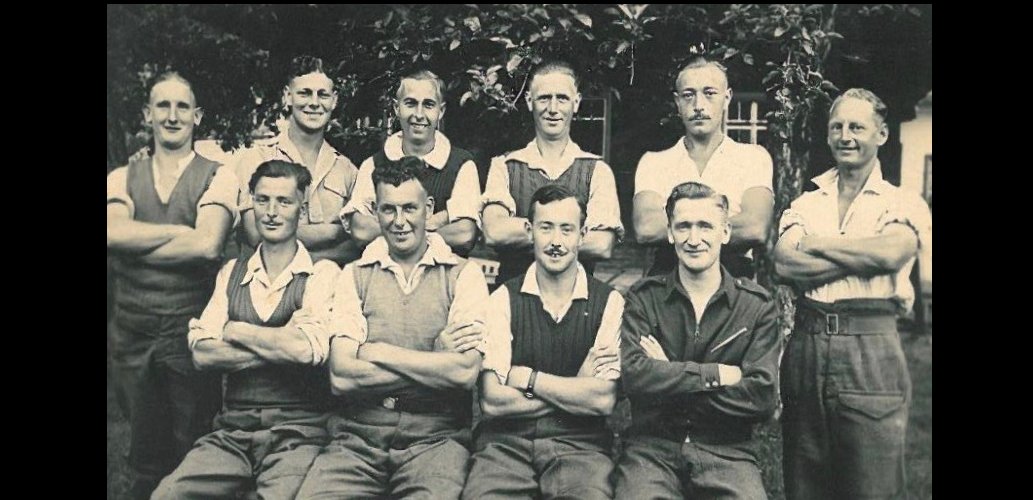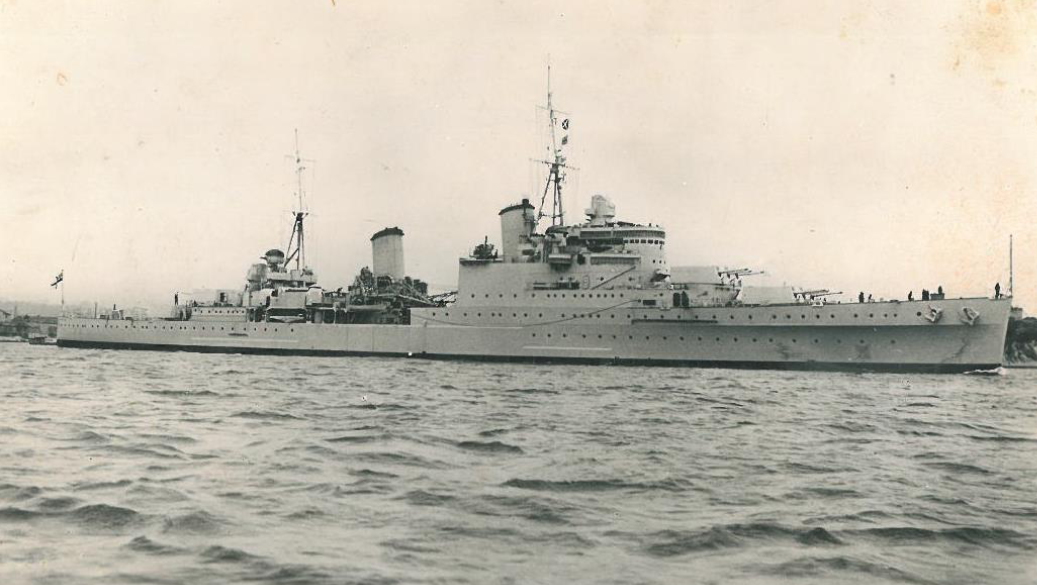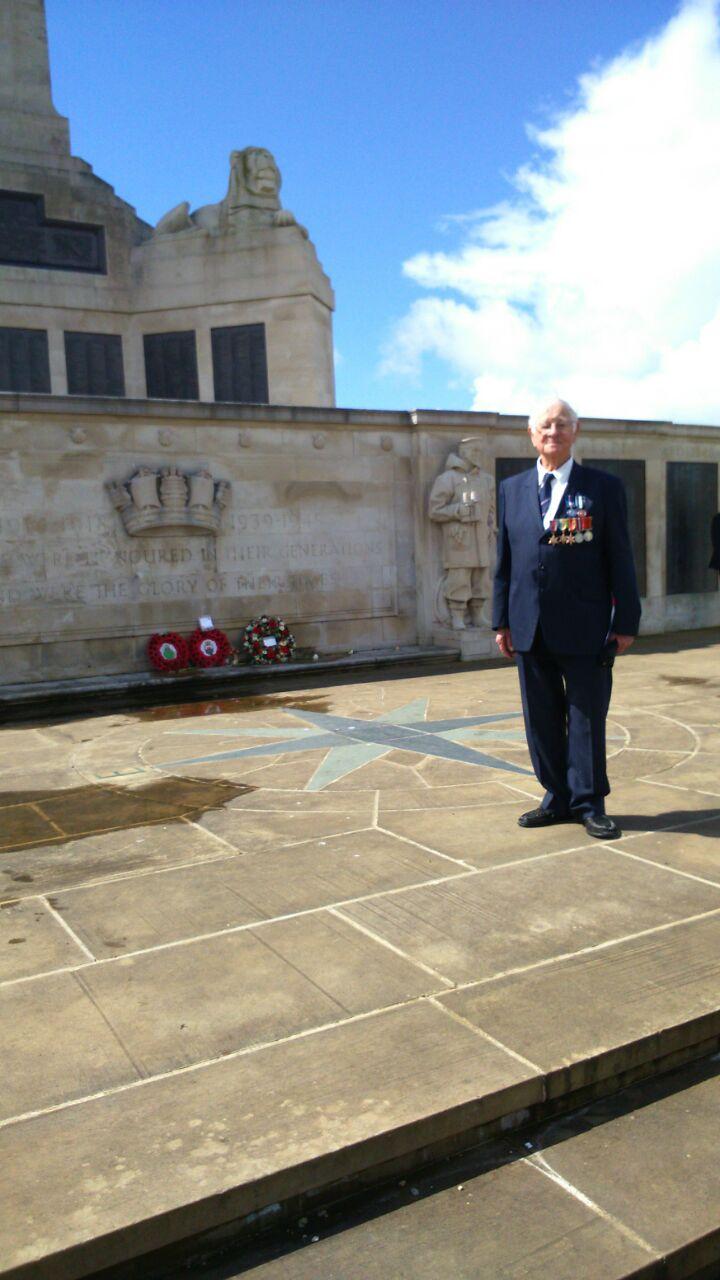
Disclaimer: Any views expressed by individuals and organisations are their own and do not in any way represent the views of The Heritage Portal. If you find any mistakes or historical inaccuracies, please contact the editor.
Below is the epilogue of Mel Baker's remarkable story. It covers his return to Wernersdorf on two occasions and his reunions with fellow POWs over the years. It also highlights the powerful commemorative events that he has been part of. Click here to view an index of Mel's story and here to download the full account including footnotes. The photo above shows the work party at Wernersdorf (Back Row Standing: Dicky Bracken; Melvin Baker; Andy Andreason; Bert Widdop; Eric Churchman; Freddie Webster. Front Row Seated: Les Bagley Lofty Shepherd; Lex McRae; Bob Bryce).
After the war I spent three months in Port Elizabeth waiting for discharge and final pay. I went back to my pre-war employer, the firm of accountants FW Anton Eveleigh, for a while. Before the war I had served three years of my articles. After the war I was let off the last two years of my articles as I had been in military service for over two years. We were given a government grant for study purposes, and I went to the University of Cape Town for a year. Then I got a job in Uitenhage at Goodyear Tyre and Rubber company. I was only there for five months when my former employer enticed me back to auditing with the incentive of one day becoming a partner. During this time I did not qualify as a chartered accountant and was not very happy with the boring job of auditing. Mangolds, an agricultural and engineering business, offered me a job setting up their engineering and accounting section when they separated from the agricultural section. At this time I got married (1949). Shortly afterwards my wife was expecting and housing was at a premium in Port Elizabeth. I was offered a job with housing in King William’s Town where I was an accountant in a big textile factory (Good Hope Textiles). My daughter Patricia was born in Port Elizabeth and five and a half years later my daughter Marian was born in King William’s Town.
In 1964 I was able to get three months leave and went to England with my wife, Joan. In London I managed to trace Eric, who had moved house. I had met up with him after the war and visited him several times at his home in London. I only had his old address, but a neighbour kindly gave me his new address. He was the only one of the original ten in Wernersdorf that I knew how to contact. We had a few drinks to celebrate. I travelled to Grantham where Lofty lived and managed to find him, and he took me to see Les, who lived not very far away. The three of us had a few noggins together. After a couple of days with Lofty I moved on to Keighley in Yorkshire and traced Bert through the local police, who gave me his son’s address. So now I had managed to make contact with all four of the Englishmen.
I hired a station wagon in London and crossed the Channel and made my way down the Rhine into Austria and carried on south to Wernersdorf. We went to the Knappitsch residence and found they were still there in the same house. The bauer and his two remaining sons were there, but the frau had died shortly before. I was welcomed like a long-lost son and heard of the fate of his other two sons, the two SS men who didn’t make it. There was still no news of Franz whom the partisans had got earlier on. The younger son, Paul, got home at the end of the war, but the Russians found him and took him away. Despite many enquiries made by the Red Cross they never managed to get any news of what happened to him. We sat around a table on the verandah of the house and about a dozen locals arrived to greet me. Each one insisted on buying a beer which came in a huge tankard that was put in front of me and then passed round the table. I was not allowed to buy a round. Things had not changed – we still all drank out of the same tankard. So many people welcomed me that Joan said to me, “Whose side of the war were you on?” There were so many coming and going because I had been all round the district and met up with more locals than the other POWs.
Things had changed drastically as far as farming was concerned. All the farms, except one, had tractors and expensive motor cars. Several locals had BMWs, Volvos or Mercedes. All the roads were tarred and all houses had electricity and implements were all power-driven. While in Wernersdorf, I heard that Bob had died. He had kept in touch with the family he worked for all these years and they were notified of his death. He was at a dance and just collapsed on the dance floor. What a way to go at the age of 43. In 1974 I made another visit to England and Europe. We hired a motor van and once again visited Wernersdorf. By now the bauer had also died and among the other people I met was my old girlfriend, Paula. Quite a few of the old people had also passed on by then. Once again I was made very welcome and met Hans’s daughter who had been living in Switzerland and had learnt to speak English while living in Canada. She had married a Swiss. They had now turned part of their house into a gasthaus, and quite a few people came and went to have a drink. The daughter plied me with drinks and said she wanted to make me drunk – she didn’t succeed.
In 1978 Joan and I went on a trip to Australia and New Zealand. We arrived in Sydney and I managed to find Andy’s name in the telephone directory and was invited to stay with him while in Sydney. He was now driving a petrol truck for Shell. I managed to contact Bob’s widow who told me that Bob had often spoken about the others and me, and our days in Wernersdorf.
The next stop was in Rotorua in New Zealand where I met up with Dick. He had visited South Africa to support the All Blacks touring side in 1976 and he and his wife had stayed with us in East London. We used Rotorua as our home from home during the six weeks that we were in New Zealand and Dick at one stage very kindly lent us his car to visit the eastern part of North Island. We got a bus and train season ticket and made our way to South Island to Dunedin, where I was told Lex was a professor at Otaga University. I phoned the University and managed to make contact with him. We spent a few days there, then back to Rotorua, back to Australia and home. The first thing Lex said to me was, “Ein man essen.” He had not forgotten, and I don’t think forgiven me, for beating him to it.
In 2001 I went back to Kythera, where we had spent our first ten days of captivity. I had been able to contact the Fighting G Club, a club for the survivors and relatives of all the HMS Gloucester crew. I found out about the Fighting G Club by seeing in the Navy News mention of a book written by the son of one of the Gloucester’s crew who lost his life when we were sunk on the 22nd of May 1941 (Ken Otter: author of the book). I wrote to the publisher suggesting to them that as I was a survivor, maybe they could supply me with a copy, otherwise inform me where I could acquire one. I didn’t hear from the publisher but received a letter from the Fighting G Club saying, “We have found our 16th survivor.” They also told me that they held an annual reunion in Plymouth on the nearest Sunday to the 22nd of May to commemorate the 730 men who were lost on the Gloucester. Also, they informed me that a visit was planned for survivors and interested members of the club to visit the island of Kythera. The Royal Navy had agreed to take the survivors and the party to the spot where the Gloucester lies at the bottom of the Mediterranean Sea. I went to Plymouth with my second wife Cynthia (Joan died in 1992) and my daughter Marian and her partner Fred. We were very warmly received. Then Cynthia and I went to Kythera where my elder daughter Patricia joined us. On the second day there we got up early and saw the RN frigate HNS Northumberland coming into the bay and dropping anchor. The ships’ company were allowed shore leave.
The HMS Gloucester from a postcard which Mel Baker sent home to South Africa prior to 1941
The next day the ship provided an armed guard which was led by the six survivors present from the place where the first survivors landed to the house where we were imprisoned (I was landed in a dinghy in front this house). This time we were properly dressed! The local population lined the road and cheered and threw rose petals as we passed. We also had the additional escourt of the local band. A plaque about the Gloucester in both English and Greek was unveiled by the local mayor and the royal naval Commodore. Nicos, the young lad who fed us, now 75 was presented with a medal by the Fighting G Club for what he had done for us 60 years before. It is inscribed ‘For he who dares.’ After the ceremony the Greek band said they knew the British anthem, and played “God save the Queen” to a rather strange tune.
The following day we were taken to sea on HMS Northumberland and stopped over the place where the Gloucester was said to lie. To me it was the wrong place. When we were sunk we could see two islands, but from the frigate there was nothing in sight. A very moving service was held on the quarterdeck of the ship. Several wreaths and tributes were put into the sea. The survivors all signed the ship’s register, and the captain presented each of us with a ship’s crest. We were fed a fabulous meal prepared by the ship’s chefs – no longer known as cooks. There was no comparison with what we had in 1940. From Kythera, back home. We were only home for a month when I had a phone call. A friend of Cynthia’s saw the 10th Gloucester in Durban harbour. She went to the docks and demanded to see an officer on the Gloucester. A lieutenant commander came to her and she told him that her friend’s husband was a survivor of the 9th Gloucester. This led to a phone call from the Lieutenant-Commander asking if I could come to Durban and join the ship for a day while they were doing a joint exercise with the South African Navy. The hull of an old trawler was towed out to sea and used for target practice with a 4.5” gun. So off we went to Durban and were given a wonderful reception by the Captain and officers of the ship.
I still keep in touch with the Fighting G Club and have attended several reunions in Plymouth. I also went to Portsmouth with Patricia for the decommissioning of the 10th Gloucester. In May 2013, we (Patricia, Marian, Fred and I) went to the Plymouth Hoe to be part of a service commemorating the sinking of the HMS Gloucester. We laid a plaque in a garden of remembrance on the Hoe. My last commemorative trip was to the Mediterranean in 2014 to pay my own tribute to my lost shipmates from the bridge of the Norwegian Jade, approximately 20 miles from where the Gloucester lies. I was given a grant for this from Heroes’ Return 2, funded by the British Lotto, and paid via the Fighting G Club, to visit my battle ground, which was the Eastern Mediterranean.
Mel Baker at the Presbyterian Church in Bedford on Remembrance Day
For those that are interested a team from the Imperial War Museum conducted an interview with Melvin Baker in 2008. Click here to listen.
Comments will load below. If for any reason none appear click here for some troubleshooting tips. If you would like to post a comment and need instructions click here.


